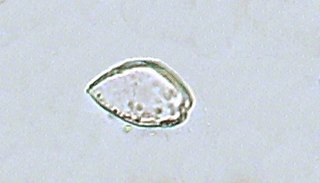
The Prorocentrales are a small order of dinoflagellates. They are distinguished by having their two flagella inserted apically, rather than ventrally as in other groups. One flagellum extends forward and the other circles its base, and there are no flagellar grooves. This arrangement is called desmokont, in contrast to the dinokont arrangement found in other groups. Accordingly, the Prorocentrales may be called desmoflagellates, and in some classifications were treated as a separate class Desmophyceae.

The Fucales (fucoids) are an order in the brown algae. The list of families in the Fucales, as well as additional taxonomic information on algae, is publicly accessible at Algaebase.

Leathesia marina (Lyngbye) Decaisne, 1842, previously known as Leathesia difformis Areschoug, 1847, commonly known as the sea cauliflower the sea potato, and brown brains is a species of littoral brown algae in the class Phaeophyceae and the order Ectocarpales, which is commonly attached to other seaweeds and sometimes rocks. When young, the organism is solid but as it matures it becomes hollow and somewhat convoluted and has the appearance of a small leathery brown bag about the same size as a tennis ball. The texture is rubbery and the outer surface smooth.

AlgaeBase is a global species database of information on all groups of algae, both marine and freshwater, as well as sea-grass.
Bryopsidella is a genus of green algae in the family Bryopsidaceae.

The Rivulariaceae are a family of cyanobacteria within the Nostocales in which the filaments (trichomes) are tapered from wider at the base to narrower at the tip.
Pyrenomonas is a genus of cryptomonad.

Erythrotrichiaceae is a red algae family in the order Erythropeltidales.

Erythrotrichia is a red algae genus in the family Erythrotrichiaceae. In Iceland, E. carnea is red listed as a vulnerable species (VU).

Cyanidiophytina is a subdivision of red algae.

Michael Dominic Richard Guiry, is an Irish botanist, who specialises in phycology (algae). See for example the articles. He is the founder and director of the algal database, AlgaeBase.

Palmariaceae is a family of algae. It includes the edible seaweed dulse.

Cyanidiaceae is a family of red algae, one of two families in the Division Cyanidiophytina.
Galdieriaceae is a family of red algae, one of two families in the order Cyanidiales.









